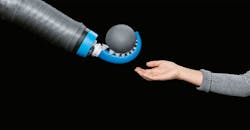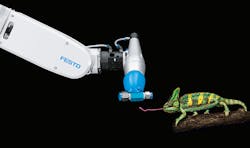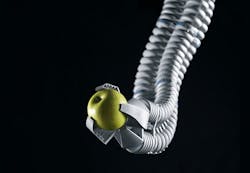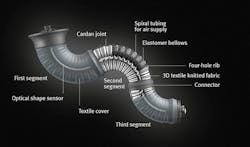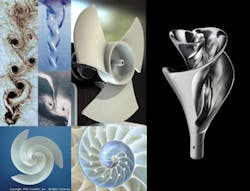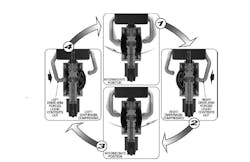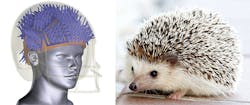Natural Selection: Biomimicry Becomes Industry's Best Option
If industrial designer Elias Knubben gets stuck on a new project, all he needs to do is Uber over to Stuttgart’s Wilhelma Zoo and inspiration is sure to strike.
This is a technique that has worked out well for him so far.
The 41-year-old German is now the head of the corporate bionics projects at Festo, overseeing the development of fantastical new innovations based on life—leveraging, among other things, the cooperative movements of creepy crawly ants or the flight patterns of elegant butterflies to create smarter, more efficient industrial robots.
During Knubben’s 11 years at Festo, the automation technology company has engaged in 45 different biomimicry projects that took their inspiration from the natural world. Whether it’s a product based on chameleon tongues, dragonfly wings or an elephant’s trunk, Festo’s portfolio owes as much to the principles found in menageries as it does mechanical engineering.
It’s all created through an innovation pipeline called the Bionics Learning Network, which links Festo to institutions, universities, startups, and inventors.
Embracing its animal nature—and hundreds of millions of years of evolution—provides a shortcut for Festo’s product development team to unlock engineering conundrums.
The point is simple: Why spend piles of cash and months of trial-and-error when the answer might be burrowed under a rock and dangling from a tree?
“We are sure that there are millions of solutions for unsolved technical problems,” Knubben says. “There are many fascinating principles worth doing research on even if we don’t have an application in mind already.”
Sometimes, though, the application is quite obvious and makes you wonder why no one thought of it earlier.
This is the case of the latest bionic concept, the OctopusGripper, a robotic end-effector that’s equal parts creepy and elegant, seemingly natural and alien. The functional concept was first unveiled at Hannover Messe Trade Fair in April.
By the reaction of the crowd, which included several potential industrial customers, the bionics program has hit a new stage in evolution.
“Showing a bird or kangaroo or butterfly always got a lot of media attention, but not always that much customer attention,” Knubben says of past events touting bionic gripping and handling devices. “This year we really got both, which was amazing for us.”
Based off possibly the most intelligent invertebrate, the OctopusGripper uses pneumatics, soft materials, and suction cups to solve the robotic picking problem currently haranguing the industry: moving irregularly shaped objects.
One of the drawbacks of robotic pickers for this task is that their shape and design pigeonholes them into one task—they’ll do that repetitive task very efficiently, but changing SKUs to a different shape and/or weight is not easily accomplished.
“Each gripper is different, but in principle, they’re doing the same thing,” Knubben says.
They pinch, grab, stick, and suck to place cans or boxes in and out of cans or boxes or onto and off conveyors.
“There are so many different shapes, that it’s a problem for them to grip objects softly, not damaging potatoes or tomatoes or eggs,” Knubben says.
Knubben’s team knew there had to be a solution that could solve this manufacturing dilemma, some flexible, soft material out there in nature that can adapt to its environment.
As it turns out, it’s something figured out at least 300 million years ago, the same age as the oldest octopus fossil.
Release of the Robo-Kraken
Creating the perfect bionic arm has been a running theme at Festo since 2010, with the Bionic Handling Assistant. This flexible 3D-printed robotic arm end moves like an elephant trunk and is capped with a three-pronged gripper. Visually, though, it looked more like one of Dr. Octopus’s tentacles than a pachyderm’s proboscis.
The OctopusGripper, however, would never be confused with a supervillain weapon, and be more likely to work tentacle-to-shoulder with humans on an assembly line or distribution center. The outer surface is soft silicone, which covers a textile material that fills with pneumatics, up to 2 bar, to provide movement.
As the air chamber expands, the OctopusGripper begins to curl around an object as a real octopus would. If it ever hit you, it would do about as much damage as a Dr. Scholl’s orthotic foot insert. If it grabbed you, it would feel like you were getting your blood pressure measured.
For demonstration purposes, the OctopusGripper has been attached to Festo’s BionicMotionRobot, a pneumatic robot arm with 12 degrees of freedom based on the best traits of an elephant trunk and octopus tentacle.
Real octopi, of course, have suction cups to keep their prey from wriggling away, a feature also used by many conventional grippers. Here, each suction cup has a tiny tube running from it to a Venturi valve that converts pressure to a vacuum.
The biomimetic design also doesn’t require an additional sensor, even if it’s picking up a tomato or any other fragile good, because the force is applied evenly to the entire surface.
One issue Festo wants to resolve prior to releasing this robo-kraken is modifying the suction control.
“If not all the suction cups are attached, then you could have quite a lot of leakage,” Knubben says. “And the force could be stronger if tiny valves were used.”
The gripper would be required to hold up to three kilograms with the BionicMotionRobot, so Knubben might have to spend some nights watching Animal Planet for the proper inspiration for this new problem.
Nature’s Laboratory
Biomimicry as a recognized discipline has only been around since biologist Janine Benyus published her book Biomimicry: Innovation Inspired by Nature in 1997. But the most well-known biomimetic innovation dates back four decades prior, when a burr sticking to a dog led to the creation of Velcro. Later, engineers would begin copying the unique textures of lotus leaves to create surfaces that repel liquids and bacteria.
Now science is on the verge of becoming a standard innovation practice, as more companies are hiring biologists or at least consulting with them in their R&D works recently. Fortune recently called biomimicry one of the “5 Trends to Ride in 2017.”
For Australian inventor Jay Harman, riding the organic wave isn’t a fad, but a way of life. He founded an engineering company that drew ideas from naturally occurring fluid systems a year before Benyus’ book, and hasn’t stopped since.
With Mother Nature as his muse, Harman has become a serial entrepreneur. His most recent company, PAX Scientific, “captures the forces of nature” to create more efficient industrial fans, pumps, and blowers.
He also wrote the 2013 book, The Shark’s Paintbrush, which details how biomimicry is good for the environment and the innovation process. For him, the methodology is the original way to work smarter, not harder.
“Nature has already solved virtually every problem that humans experience,” Harman says. “Manufacturing is a particularly ripe industry for bio-inspired innovation, because gathering raw materials and assembling them into functioning subsystems and systems while using the minimum of materials and energy are some of the most common processes in nature.”
Just as the most efficient companies survive down economic times, efficient animals survive ice ages, asteroid impacts, and urban sprawl.
Noticing an evolutionary advantage and how it might fit into a process or be turned into a tool is only the easy part. Bringing it into a product takes a lot more.
“The extraordinary capabilities of cephalopods have always been admired,” Harman says. “Translating those capabilities is now within reach thanks to modern materials, sensors, and controls, but it takes commitment and trial and error to get it right. So I give Festo top marks for their work on the OctopusGripper.”
For any company hoping to industrialize bee swarm choreography or Harman recommends bringing in a consultant, which can be found through Biomimicry 3.8.
“Larger firms are hiring full-time biologists, chemists, geologists, and so on,” Harman says. “But that can wait until you see some success and your leadership team understands what type of scientist would best suit your needs.”
Doctor Do-a-Lot-with-a-Little
Evolution takes time, which itself is a problem when considering biomimetic solutions. The field is so nascent, industrial engineers with a biology background or biologists with manufacturing expertise are rare breeds.
In an environment, if you have a niche no other species can fill, such as a woodpecker drilling for dinner, you will reap the rewards of a full belly and the chance to pass on your DNA, which is all any of us can really ask for.
This is why the Great Lakes Biomimicry, much like Festo, has created its own network between industry and universities. The non-profit in Northeast Ohio recruited companies including Sherwin-Williams and Lubrizol to sponsor Ph.Ds at the University of Akron for its fledgling biomimicry program as a way to reclaim the Rust Belt as a hub of biomimicry, the Cuyahoga Valley standing in for the tech-centric Silicon Valley.
The Ph.Ds worked closely with the manufacturers’ product development teams and offered a biological perspective.
The first fellow to receive her doctorate from the university, Emily Kennedy, teamed with GOJO to develop a more energy-efficient design for its automated soap dispensers.
Kennedy got bit by the biomimicry bug in New South Wales, Australia during a study abroad at the University of Wollongong, researching how the jewel beetle can detect fires up to 50 miles away with chemical sensors, which they would journey to as burnt bark is the only suitable nursery for their larvae.
An environmental scientist with notions of saving the world, Kennedy deduced this could be used for low-cost fire detectors in developing nations, and now believes biomimicry is the driver of truly sustainable practices.
"It frames sustainability more as an economic opportunity versus how do we cut carbon emissions or use less water," she says.
For GOJO, Kennedy investigated how cobras spit venom as one possible solution, before settling on a human heart-inspired double-acting bladder pump that uses arms to compress left and right diaphragms.
“It’s projecting 50% energy savings and uses fewer batteries, is more lightweight, with lower transportation costs,” says Kennedy, whose team was up against an IP landscaping model as a control group to check the efficacy.
“And there are fewer batteries in landfills after,” Kennedy adds.
The case study historical project used nearly six times more man hours at almost six times the budget, yielding only 20% in energy savings. “We found was using biological models during the front end of innovation really accelerated the rate of intellectual property generation and led to more radical versus incremental ideas and led to more sustainable solutions,” she says.
To get recruits and support for her project “took a lot of convincing and a high-level supporter,” Kennedy says. “You need a champion.”
Besides buy-in, another issue is plant infrastructure.
“In biology, a lot of the so-called parts are made of soft materials,” she says. “And I think that a lot of manufacturing plants are better equipped for handling hard materials.”
The pumps Kennedy helped develop leverage elastic recoil for the pumping force.
“That can be a little scary because if you want to make a state-of-the-art model, it might require reformatting of the plant,” Kennedy says. “That could be a major hurdle.”
Currently, Kennedy is the CEO of Hedgemon, a startup developing a helmet insert based on a hedgehog’s quills to absorb impacts and reduce concussions.
With the economic and environmental advantages biomimicry offers, Kennedy is certain she has found her niche.
“There’s definitely some technique that goes into translating that from the natural world into technology,” says Kennedy.
To help, there are resources such as engineering-to-biology thesauruses available to help convert mechanical properties to organic chemistry, though having an actual biologist was instrumental to Festo and GOJO’s success.
The big—and possibly humbling—takeaway from the biomimicry bloom is that the engineering solution you need might not spew forth from your top talents’ minds, but by looking in the air or under the sea, somewhere out in nature.
“It’s basically just a huge treasure trove of ideas,” Kennedy says.
So start digging.
About the Author
John Hitch
Editor, Fleet Maintenance
John Hitch, based out of Cleveland, Ohio, is the editor of Fleet Maintenance, a B2B magazine that addresses the service needs for all commercial vehicle makes and models (Classes 1-8), ranging from shop management strategies to the latest tools to enhance uptime.
He previously wrote about equipment and fleet operations and management for FleetOwner, and prior to that, manufacturing and advanced technology for IndustryWeek and New Equipment Digest. He is an award-winning journalist and former sonar technician aboard a nuclear-powered submarine where he served honorably aboard the fast-attack submarine USS Oklahoma City (SSN-723).
